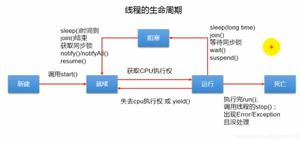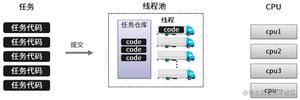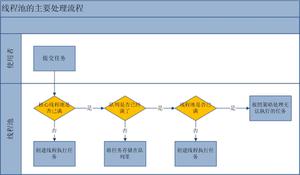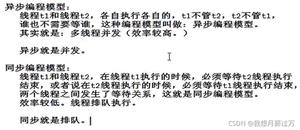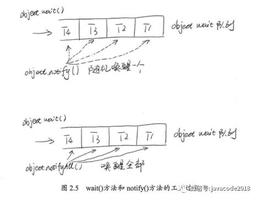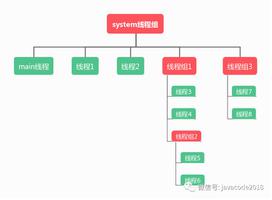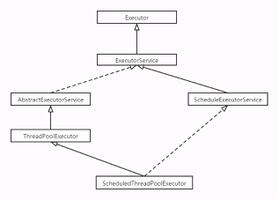Java多线程-新特征-原子量

所谓的原子量即操作变量的操作是“原子的”,该操作不可再分,因此是线程安全的。
为何要使用原子变量呢,原因是多个线程对单个变量操作也会引起一些问题。在Java5之前,可以通过volatile、synchronized关键字来解决并发访问的安全问题,但这样太麻烦。
Java5之后,专门提供了用来进行单变量多线程并发安全访问的工具包java.util.concurrent.atomic,其中的类也很简单。
package cn.thread;import java.util.concurrent.atomic.AtomicLong;
public class AtomicRunnable implements Runnable {
private static AtomicLong aLong = new AtomicLong(10000); // 原子量,每个线程都可以自由操作
private String name; // 操作人
private int x; // 操作数额
AtomicRunnable(String name, int x) {
this.name = name;
this.x = x;
}
public void run() {
System.out.println(name + "执行了" + x + ",当前余额:" + aLong.addAndGet(x));
}
}
package cn.thread;import java.util.concurrent.ExecutorService;
import java.util.concurrent.Executors;
import java.util.concurrent.atomic.AtomicLong;
/**
* 多线程-原子量
*
* @author 林计钦
* @version 1.0 2013-7-26 下午04:13:45
*/
public class ThreadAtomicTest {
public static void main(String[] args) {
ExecutorService pool = Executors.newFixedThreadPool(2);
Runnable t1 = new AtomicRunnable("张三", 2000);
Runnable t2 = new AtomicRunnable("李四", 3600);
Runnable t3 = new AtomicRunnable("王五", 2700);
Runnable t4 = new AtomicRunnable("老张", 600);
Runnable t5 = new AtomicRunnable("老牛", 1300);
Runnable t6 = new AtomicRunnable("胖子", 800);
// 执行各个线程
pool.execute(t1);
pool.execute(t2);
pool.execute(t3);
pool.execute(t4);
pool.execute(t5);
pool.execute(t6);
// 关闭线程池
pool.shutdown();
}
}
运行结果:
张三执行了2000,当前余额:12000王五执行了2700,当前余额:14700
老张执行了600,当前余额:15300
老牛执行了1300,当前余额:16600
胖子执行了800,当前余额:17400
李四执行了3600,当前余额:21000
张三执行了2000,当前余额:12000李四执行了3600,当前余额:15600
老张执行了600,当前余额:18900
老牛执行了1300,当前余额:20200
胖子执行了800,当前余额:21000
王五执行了2700,当前余额:18300
张三执行了2000,当前余额:12000王五执行了2700,当前余额:14700
李四执行了3600,当前余额:18300
老牛执行了1300,当前余额:20200
胖子执行了800,当前余额:21000
老张执行了600,当前余额:18900
从运行结果可以看出,虽然使用了原子量,但是程序并发访问还是有问题,那究竟问题出在哪里了?
这里要注意的一点是,原子量虽然可以保证单个变量在某一个操作过程的安全,但无法保证你整个代码块,或者整个程序的安全性。因此,通常还应该使用锁等同步机制来控制整个程序的安全性。
下面是对这个错误修正:
package cn.thread;import java.util.concurrent.atomic.AtomicLong;
import java.util.concurrent.locks.Lock;
public class AtomicRunnable2 implements Runnable {
private static AtomicLong aLong = new AtomicLong(10000); // 原子量,每个线程都可以自由操作
private String name; // 操作人
private int x; // 操作数额
private Lock lock;
AtomicRunnable2(String name, int x, Lock lock) {
this.name = name;
this.x = x;
this.lock=lock;
}
public void run() {
lock.lock();
System.out.println(name + "执行了" + x + ",当前余额:" + aLong.addAndGet(x));
lock.unlock();
}
}
package cn.thread;import java.util.concurrent.ExecutorService;
import java.util.concurrent.Executors;
import java.util.concurrent.atomic.AtomicLong;
import java.util.concurrent.locks.Lock;
import java.util.concurrent.locks.ReentrantLock;
/**
* 多线程-原子量
*
* @author 林计钦
* @version 1.0 2013-7-26 下午04:13:45
*/
public class ThreadAtomicTest2 {
public static void main(String[] args) throws InterruptedException {
ExecutorService pool = Executors.newFixedThreadPool(2);
Lock lock = new ReentrantLock(false);
Runnable t1 = new AtomicRunnable2("张三", 2000, lock);
Runnable t2 = new AtomicRunnable2("李四", 3600, lock);
Runnable t3 = new AtomicRunnable2("王五", 2700, lock);
Runnable t4 = new AtomicRunnable2("老张", 600, lock);
Runnable t5 = new AtomicRunnable2("老牛", 1300, lock);
Runnable t6 = new AtomicRunnable2("胖子", 800, lock);
// 执行各个线程
pool.execute(t1);
pool.execute(t2);
pool.execute(t3);
pool.execute(t4);
pool.execute(t5);
pool.execute(t6);
// 关闭线程池
pool.shutdown();
}
}
运行结果:
李四执行了3600,当前余额:13600王五执行了2700,当前余额:16300
老张执行了600,当前余额:16900
老牛执行了1300,当前余额:18200
胖子执行了800,当前余额:19000
张三执行了2000,当前余额:21000
这里使用了一个对象锁,来控制对并发代码的访问。不管运行多少次,执行次序如何,最终余额均为21000,这个结果是正确的。
有关原子量的用法很简单,关键是对原子量的认识,原子仅仅是保证变量操作的原子性,但整个程序还需要考虑线程安全的。
以上是 Java多线程-新特征-原子量 的全部内容, 来源链接: utcz.com/z/394181.html

